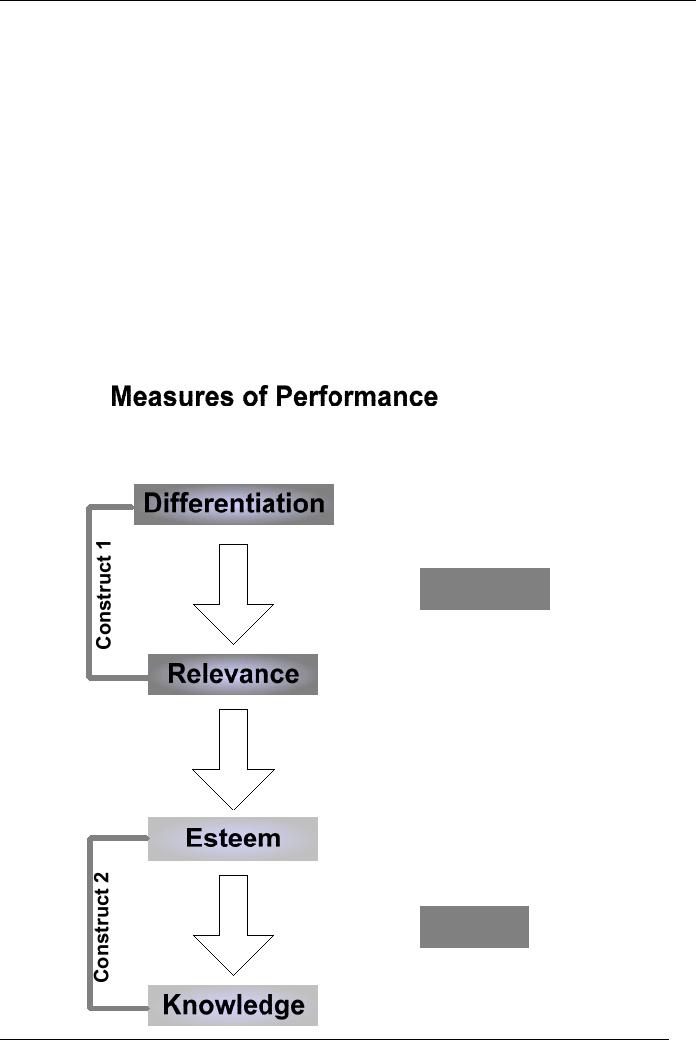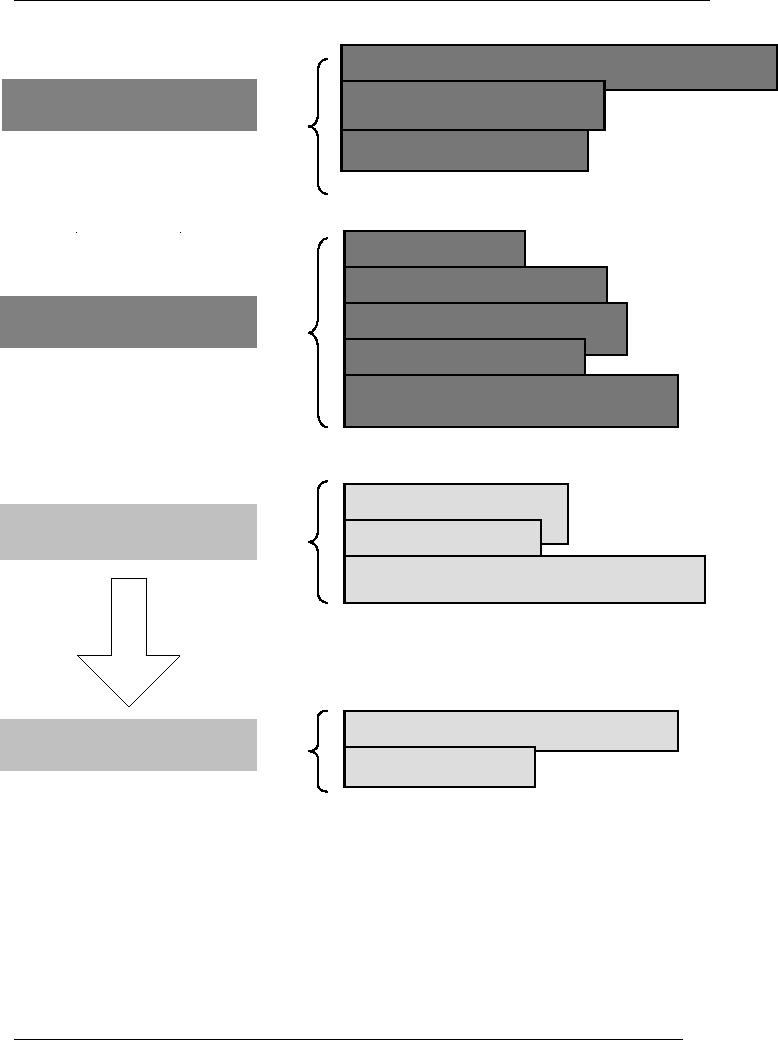 |

Brand
Management (MKT624)
VU
Lesson
39
RETURN
ON BRAND INVESTMENT
ROBI
Introduction
All
strategic moves are made
according to a game plan
that we have learnt through
different
stages
of the brand management process.
From brand picture to
positioning to channels to
communication
are all strategic
formulations that require
investment. If these formulations
are
put
right, the result you get is
brand value and profitability. To
what extent the strategies
in
place
are giving return on brand
investment should be measured so
that you can make
adjustments
in your strategic moves
whenever and wherever those are
required. The lecture
throws
light on that!
Return
on brand investment ROBI
The
basic idea of ROBI is to
measure brand's performance. To
manage your brand well,
you
have
got to measure its movement
in terms of changing preferences and
loyalties. The most
important
challenge here is to see that
loyalty to the brand does
not erode, for it is one
basic
measure
of keeping your customers,
bringing in new ones, and
keeping them loyal as
well.
There
are different measures that
are employed to gauge the
strategic movement and growth
of
your
brand. Such measures allow
insights into the following
factors or formulations
that
organizations
have in place to ensure growth of their
brands:
�
Allow
to see that overall
strategic movement is according
to the strategic
plans.
�
Offer
insights into any changes
that may be required in
adjusting
brand position or
further
strengthening it.
�
Let
you adjust or reinforce
communication
plans for
consistent focus.
�
Offer
insights into provision
of resources in a more
effective way.
�
Let
you identify brand strength
and potential
areas of growth within and
across
categories,
that is, line or brand
stretch.
Why
measure performance?
It
can be argued that in the presence of
accounting measures like
revenues, margins, and
returns
on
revenues and investments, why measure
brand's performance? The
achievement of financial
goals
is a requisite of the highest
order. What else is needed?
These are interesting
questions
and
should be answered.
Beneath
the surface of accounting and
other statistical figures
are strategic
factors that
cause
subtle
changes to brand's movement as
time passes by. It therefore
becomes important to
track
such
changes in order to make right decisions
and adjust tactical moves
relating those changes.
In
other words, we
measure, on the one hand,
financial results, and, on
the other, strategic
factors
that cause those
results.
Brand
dynamics
There
is a cause-and-effect relationship
between strategic factors and
financial measures.
The
strategic
factors, according to the
most relevant brand equity
model by Young and
Rubicam
(Y&R)
are1:
1.
Differentiation
2.
Relevance
3.
Esteem
4.
Knowledge
153

Brand
Management (MKT624)
VU
According
to this model brands are
built sequentially according to
the four factors as shown
in
the
graphic illustration.
Figure
43
Differentiation
comes
first, as no brand
with
Model
of Brand Dynamics
ambitions
can become strong unless it
has a
point
of real differentiation. It is the
bottom line
Differentiation
characteristic
of any brand that seeks to
acquire
price
premium or a decent price with
good
margins.
Relevance
is
next on the model. It means
that a
brand
must have clear meaning
for its users.
Unless
it is relevant for the
target market, it will
Relevance
not
buy it, despite being
much differentiated.
Very
expensive professional cameras
and
chronograph
wrist watches are
much
differentiated,
but they have an appeal
for a
niche
market and not a large
target market.
Therefore,
they are no good for a
common
Esteem
customer.
If
a brand has differentiation and is
highly
relevant
for a big market, it becomes
a big seller
and,
hence very strong.
Brand
strength, then, is a
function of
differentiation
and relevance.
Knowledge
We
can say that
Source:
Building Strong Brands by
David A. Aaker
Brand
strength = Differentiation
multiplied
by
relevance
We
must try for our brands to
become strong on both
characteristics, which offer
one
"construct"
of brand strength. The other
"construct" comprises of the other
two dimensions that
are
esteem
and
knowledge.
Esteem multiplied by knowledge is
the brand stature construct.
See
the
graphics on the following
page.
Esteem
refers
to perceived quality and a rise or
decline in popularity. Customers loyal to
their
brands
hold them in high esteem
owing to the quality
perceptions. Esteem then has
a direct
relationship
with loyalty.
Knowledge
illustrates
that customers are not
only aware of the brand and
its product, but also
understand
the reason for this
product's existence. They
are aware of the positioning of it
and
have
a true understanding of the
brand. That is the height of
the brand building
process.
The
four dimensions have further
variants. You study their
variants within the two
major
constructs
and choose which ones are
most relevant for measuring
performance of your
brand.
In
other words, the performance
and subtle changes that are
caused over time stem from
these
dimensions.
Starting with awareness,
recognition, and recall, these
dimensions end with
referral
index.
As
a reminder, these measures
are carried out along
side routine financial
results to complete a
balanced
brand-building process. One
important beginning about
these measures is that
they
154

Brand
Management (MKT624)
VU
require
researching across a representative sample of
your customers. Maintaining a
contact
with
them leverages your knowledge of
the brand in a much more
structured way. You can also
improve
upon the brand-based customer
model that is a composite of
brand picture, brand
contract,
and positioning.
Let
us now take a look at the
variants of the dimensions
that become important
strategic
measures
of brand's performance as shown by
the graphics on the page
after next.
On
the differentiation
dimension:
Awareness
and recognition: Customer's
ability to recall and recognize
the brand as a
distinct
identity
is a reflection of brand's strength.
The more differentiated it
is, the easier the
recall and
recognition.
Awareness and recognition play a
dominant role in building
brand equity. Being
in
the
minds of consumers, it also plays a
role in developing outreach
for the brand. It is similar
to
the
measure that ad agencies
undertake in establishing the
aided and unaided recalls to
gauge
the
success of their campaigns. Used as a
measure of brand performance,
recall and recognition
should
however go beyond just
measuring the level of
recall. It must provide
relevant data that
you
can relate with other
variables and gauge strategic
implications.
Figure
44
X
Strength
=
X
=
Stature
155

Brand
Management (MKT624)
VU
Figure
45
Awareness,
recognition, and
recall
Differentiation
Persona
recognition
Contract
fulfillment
Market
share
Purchase
frequency
Relevance
Customer
satisfaction
Quality
perception
Lost
and found customers
Customer
loyalty
Esteem
Price
premium
Lifetime
value of a customer
Positioning
understanding
Knowledge
Referral
index
While
carrying out research, importance
should also be given to symbols and
imagery. In many
cases,
symbols and images cannot be
separated from the brand
name when it comes to
evoking
a
recall. Question about what
comes to your mind in terms
of symbols and images while
we
mention
this name is important.
Getting
people to recall and recognize your
brand goes a long way in
building brand
equity.
The
data generated on recall and
recognition therefore should be
used very strategically
in
making
decisions about different variables of
the marketing mix.
Persona
recognition: It measures
the extent to which your
brand is consistent with its
persona.
Are
distinct and differentiated features
recognized by your customers? Basically,
it is a measure
156

Brand
Management (MKT624)
VU
that
tells you whether the
brand persona developed by
you is being received at the
customer
end
the way it was
intended!
This
measure should also be drawn on a
representative sample of your customers
to find out
how
they associate themselves
with your brand. It should
be judged by the degree to
which
customers
perceive receiving the
benefits and developing emotional
associations with your
brand.
You,
therefore, have to devise
a questionnaire that is
intended to evoke the
correct and
objective
responses. The next step is
obviously for you to compare
the results with
your
original
persona. Any variations that you detect
have to be taken care of in
relation to their
nature
and severity.
If
you intended to create a
persona of a dependable, friendly, and,
informal brand and
the
results
are contrary to that persona,
you must make adjustments
where ever those are
warranted
in quality, packaging, just
the visual part, symbols, or
maybe your
communication.
The
chances are that major
changes will not be desired, for
your persona should not be
that
much
off the mark to dictate
major changes. That will,
most probably, bring your
focus on to
the
imagery, where some
adjustments will fix the
problem
Contract
fulfillment: It measures
the extent to which the
brand upholds the contract.
Are all
promises
being delivered? This
measure gives a straightforward
report on how much
your
brand
is keeping all the promises it
has made with its
customers.
Are
customers satisfied about
whatever they think should
be delivered is being delivered? If
the
answer
is yes, then you are
keeping the contract. Any
breaches dictate that you
must repair the
contract
and win over customers'
confidence.
You
will recall this contract is
only emotional and economic in
nature. Unavailability or
erratic
availability
of a successful brand of yours
reflects flaws either in
distribution system or
company's
logistics.
Customers
expect regular availability to
reap the benefits your
brand offers. This is a breach
of
the
contract and has to be repaired. Not
being able to supply or deliver
the product through a
direct
marketing system is another breach of
contract. Compromising quality is
yet another.
Conversely,
fulfillment of the contract
builds trust in your brand.
Trust creates loyalty, which
in
itself
starts off a process of gaining
new customers on a continuous
basis.
On
the relevance
dimension
Market
share: This
measure lets you have a
clear picture of the number
of customers or usage
of
your brand in comparison
with competition.
Purchase
frequency: This
measure lets you have
the number of times your
customers buy your
brand.
Your objective becomes, "how can I
have these customers buy
more every time
they
buy?
Customer
satisfaction: This
provides a rating on the
degree of satisfaction with
your brand. It
also
shows you how much
willing customers are to stick to
your brand.
Brand-driven
penetration: You use
this measure on line and
brand extensions. It basically
tells
you
how many of your existing
customers have chosen to buy
products and services that are
an
extension
of your existing brand. It
confirms or does not confirm
the extendibility of
your
brand
by giving you a proof of to
what extent your customers
are willing to go with you
on
your
extensions. In other words, it is a
measure of how rational you
are in devising your
product
strategies.
157

Brand
Management (MKT624)
VU
Quality
perception: It is a
measure of satisfaction with
your brand; it shows
quality
comparisons
with competitors on scales
such as
�
High
quality vs. shoddy
quality
�
Best
in the category
�
Consistent
quality
Brand-driven
customer acquisition: This
measure reflects the number
of customers that you
have
gained in comparison with some
preceding period. This could
be one year. The
difference
between
two numbers (if positive) is
additional, new
customers.
To
determine the additional
customers is not as difficult as it
may sound. If you are
selling
consumer
durables like TVs, it is
pretty much straightforward.
The findings can be
very
interesting
from the standpoint of
branding strategies that you
have employed.
If
you are selling consumables in
big quantities, it may be a
little more challenging but
not
outright
impossible. Being the brand
and sales managers, you people can draw
certain bases of
consumption
in relation to population served. You can
then ascribe increased
consumption to
additional
customers based on those bases.
The basis of consumption can be per
person, per
family
of a predetermined number of members to
it.
The
measure does not end at
determining new, additional
customers. The challenging
part of
the
measure is to determine, through
the questions to respondents, what
drives them to make
buying
decisions they make and what is it that
is making them leave your
brand and for what
reasons?
Such findings are the
most fascinating part of
this measure.
Bibliography:
1.
David Aaker: "Building
Strong Brands", The Free
Press ( )
Suggested
readings:
1.
Scot M. Davis: "Brand Asset
Management Driving Profitable
Growth through
Your
Brand";
Jossey-Bass, a Wiley Imprint
(215-220)
158
Table of Contents:
- UNDERSTANDING BRANDS – INTRODUCTION:Functions of Brand Management, Sales forecast, Brand plan
- INTRODUCTION:Brand Value and Power, Generate Profits and Build Brand Equity
- BRAND MANIFESTATIONS/ FUNDAMENTALS:Brand identity, Communication, Differentiation
- BRAND MANIFESTATIONS/ FUNDAMENTALS:Layers/levels of brands, Commitment of top management
- BRAND CHALLENGES:Consumer Revolt, Media Cost and Fragmentation, Vision
- STRATEGIC BRAND MANAGEMENT:Setting Objectives, Crafting a Strategy, The Brand Mission
- BRAND VISION:Consensus among management, Vision Statement of a Fast Food Company, Glossary of terms
- BUILDING BRAND VISION:Seek senior management’s input, Determine the financial contribution gap
- BUILDING BRAND VISION:Collect industry data and create a brand vision starter, BRAND PICTURE,
- BRAND PICTURE:Brand Value Pyramid, Importance of being at pinnacle, From pinnacle to bottom
- BRAND PERSONA:Need-based segmentation research, Personality traits through research
- BRAND CONTRACT:The need to stay contemporary, Summary
- BRAND CONTRACT:How to create a brand contract?, Brand contract principles, Understand customers’ perspective
- BRAND CONTRACT:Translate into standards, Fulfill Good Promises, Uncover Bad Promises
- BRAND BASED CUSTOMER MODEL:Identify your competitors, Compare your brand with competition
- BRAND BASED CUSTOMER MODEL:POSITIONING, Product era, Image Era, An important factor
- POSITIONING:Strong Positioning, Understanding of components through an example
- POSITIONING:Clarity about target market, Clarity about point of difference
- POSITIONING – GUIDING PRINCIPLES:Uniqueness, Credibility, Fit
- POSITIONING – GUIDING PRINCIPLES:Communicating the actual positioning, Evaluation criteria, Coining the message
- BRAND EXTENSION:Leveraging, Leveraging, Line Extension in detail, Positive side of line extension
- LINE EXTENSION:Reaction to negative side of extensions, Immediate actions for better managing line extensions
- BRAND EXTENSION/ DIVERSIFICATION:Why extend/diversify the brand,
- POSITIONING – THE BASE OF EXTENSION:Extending your target market, Consistency with brand vision
- DEVELOPING THE MODEL OF BRAND EXTENSION:Limitations, Multi-brand portfolio, The question of portfolio size
- BRAND PORTFOLIO:Segment variance, Constraints, Developing the model – multi-brand portfolio
- BRAND ARCHITECTURE:Branding strategies, Drawbacks of the product brand strategy, The umbrella brand strategy
- BRAND ARCHITECTURE:Source brand strategy, Endorsing brand strategy, What strategy to choose?
- CHANNELS OF DISTRIBUTION:Components of channel performance, Value thru product benefits
- CREATING VALUE:Value thru cost-efficiency, Members’ relationship with brand, Power defined
- CO BRANDING:Bundling, Forms of communications, Advertising and Promotions
- CUSTOMER RESPONSE HIERARCHY:Brand-based strategy, Methods of appropriations
- ADVERTISING:Developing advertising, Major responsibilities
- ADVERTISING:Message Frequency and Customer Awareness, Message Reinforcement
- SALES PROMOTIONS:Involvement of sales staff, Effects of promotions, Duration should be short
- OTHER COMMUNICATION TOOLS:Public relations, Event marketing, Foundations of one-to-one relationship
- PRICING:Strong umbrella lets you charge premium, Factors that drive loyalty
- PRICING:Market-based pricing, Cost-based pricing
- RETURN ON BRAND INVESTMENT – ROBI:Brand dynamics, On the relevance dimension
- BRAND DYNAMICS:On the dimension of knowledge, The importance of measures
- BRAND – BASED ORGANIZATION:Benefits, Not just marketing but whole culture, Tools to effective communication
- SERVICE BRANDS:The difference, Hard side of service selling, Solutions
- BRAND PLANNING:Corporate strategy and brands, Brand chartering, Brand planning process
- BRAND PLANNING PROCESS:Driver for change (continued), Brand analysis
- BRAND PLAN:Objectives, Need, Source of volume, Media strategy, Management strategy